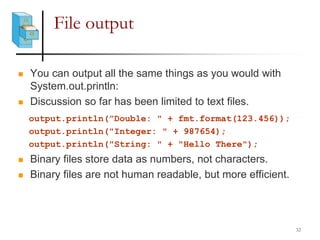The document discusses file input and output in Java. It covers the File class, opening files for reading using a Scanner, handling exceptions, reading data line-by-line and tokenizing the lines. It also discusses opening files for writing using a PrintWriter and outputting data to files. The key topics are file I/O, exception handling, and using Scanners and PrintWriters to read from and write to files in Java.
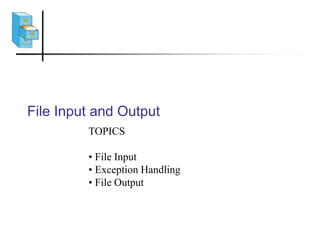
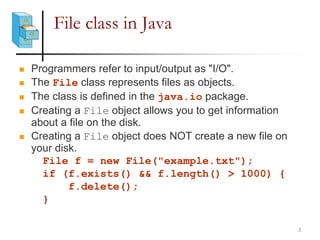
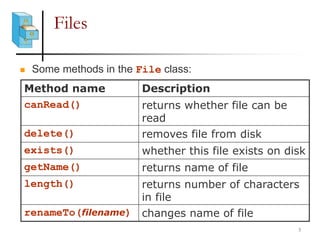


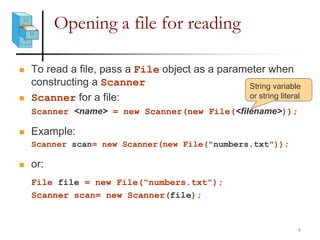


![Compiler error with files
Question: Why will the following program NOT compile?
import java.io.*; // for File
import java.util.*; // for Scanner
public class ReadFile {
public static void main(String[] args) {
File file = new File(“input.txt”);
Scanner scan = new Scanner(file);
String text = scan.next();
System.out.println(text);
}
}
Answer: Because of Java exception handling!
9](https://image.slidesharecdn.com/extrafileio-230619005227-c2493399/85/ExtraFileIO-pptx-9-320.jpg)
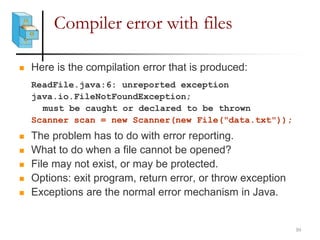
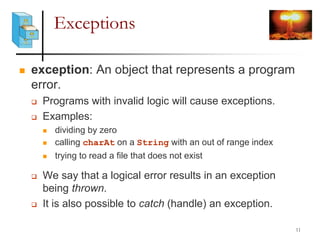

![Throwing Exceptions
throws clause: Keywords placed on a method's header
to state that it may generate an exception.
It's like a waiver of liability:
"I hereby agree that this method might throw an exception, and I
accept the consequences (crashing) if this happens.”
General syntax:
public static <type> <name>(<params>) throws <type>
{ … }
When doing file open, we throw IOException.
public static void main(String[] args)
throws IOException {
13](https://image.slidesharecdn.com/extrafileio-230619005227-c2493399/85/ExtraFileIO-pptx-13-320.jpg)
![Handling Exceptions
When doing file I/O, we use IOException.
public static void main(String[] args) {
try {
File file = new File(“input.txt);
Scanner scan = new Scanner(file);
String firstLine = scan.nextLine();
...
} catch (IOException e) {
System.out.println(“Unable to open input.txt”);
System.exit(-1);
}
}
14](https://image.slidesharecdn.com/extrafileio-230619005227-c2493399/85/ExtraFileIO-pptx-14-320.jpg)


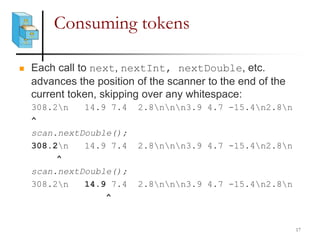

![First solution
public static void main(String[] args)
try {
File file = new File(“input.txt”);
Scanner scan = new Scanner(file);
for (int i = 0; i <= 4; i++) {
double next = scan.nextDouble();
System.out.println("number = " + next);
}
} catch (IOException e) {
System.out.println(“Unable to open input.txt”);
System.exit(-1);
}
}
19](https://image.slidesharecdn.com/extrafileio-230619005227-c2493399/85/ExtraFileIO-pptx-19-320.jpg)

![Second solution
public static void main(String[] args)
try {
File file = new File(“input.txt”);
Scanner scan = new Scanner(file);
while (scan.hasNextDouble() {
double next = scan.nextDouble();
System.out.println("number = " + next);
}
} catch (IOException e) {
System.out.println(“Unable to open input.txt”);
System.exit(-1);
}
}
21](https://image.slidesharecdn.com/extrafileio-230619005227-c2493399/85/ExtraFileIO-pptx-21-320.jpg)
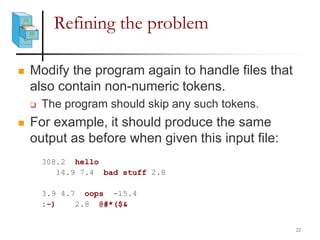
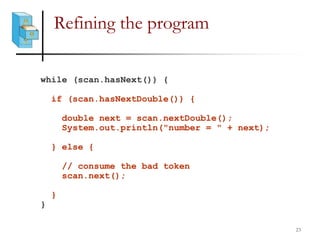
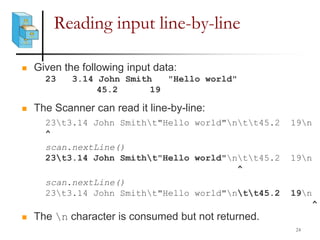
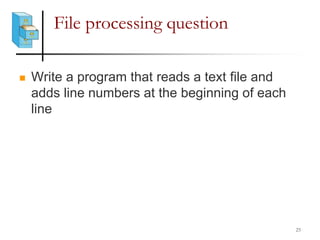


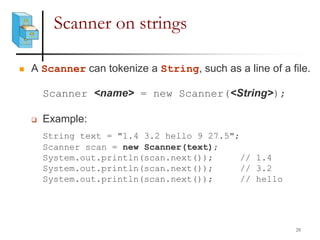
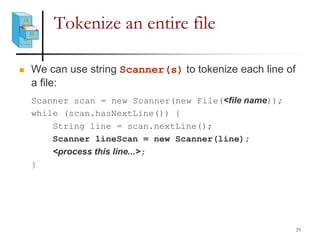
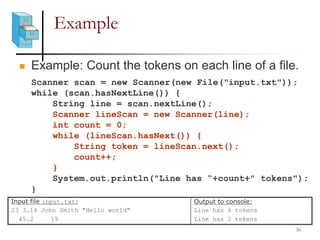
![Opening a file for writing
Same story as reading, we must handle exceptions:
public static void main(String[] args) {
try {
File file = new File(“output.txt”);
PrintWriter output = new PrintWriter(file);
output.println(“Integer number: ” + 987654);
...
} catch (IOException e) {
System.out.println(“Unable to write output.txt”);
System.exit(-1);
}
31](https://image.slidesharecdn.com/extrafileio-230619005227-c2493399/85/ExtraFileIO-pptx-31-320.jpg)
